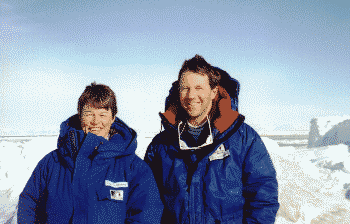
There is no wind blowing, so these people can have their faces uncovered.
Weather in Antarctica
The effects of wind and cold have a major influence on the work people can do in Antarctica. Even in summer, people watch the weather all the time. If the weather gets too bad, everyone stays safely inside.
Whiteout conditions
Sometimes under conditions where there are no shadows, for example when there is a uniformly cloudy sky over snowy ground, travellers can experience a whiteout. This is where the air may be totally clear, but because there are no marks or shadows, you can't tell what is ground, what is sky, or how close you are to an object.
In whiteout conditions even birds can fly into the snow by mistake, and aircraft can crash. The Mt Erebus crash is believed to be caused by the fact that the pilots experienced whiteout conditions.
Windchill
The temperature in Antarctica is very cold, but the wind can cause even more heat to be lost from the body. Scientists have linked the two measures together and called it the windchill factor. This is a far more accurate measure of how cold a person actually feels outside. If it is cold and still, not as much heat is lost from the body as when it is the same temperature, and a strong wind is blowing. In still air, a person can have their face showing with no problems, but if the wind gets up too far, exposed human flesh begins to freeze.

There is no wind blowing, so these people can have their faces uncovered.
Blizzards
Blizzards are a combination of strong wind and snow, and can last for many days. Sometimes the snow is falling from the clouds, but other times the snow is just blown along the ground. All outside work stops during the days that a blizzard is blowing, because visibility may fall to less than one metre. In such conditions it would be easy to get lost even going from one building to another. Blizzards can cause a lot of damage to unprotected machines and buildings.